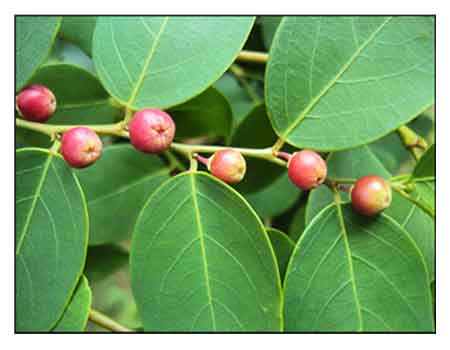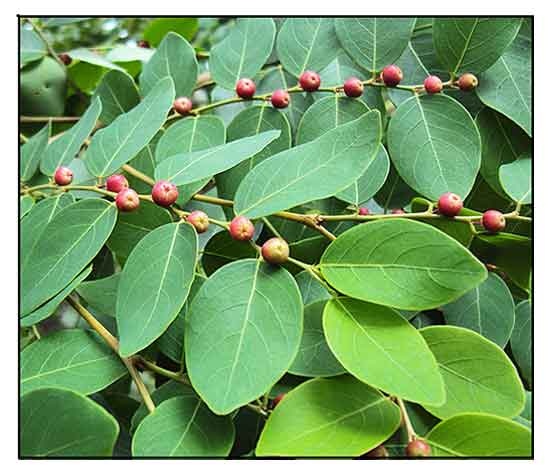 Botany Botany
Matang-hipon is an erect, monoecious, slender, smooth shrub, 1.5 to 4 meters high. Bark is yellowish gray. Leaves are distichous, elliptic to elliptic-ovate, 1 to 3 centimeters long. Flowers are very small, greenish or pink, axillary, and about 3 to 5 millimeters in diameter. Fruit is pink, purple or dull red, somewhat fleshy, nearly spherical, about 5 millimeters in diameter.
Breynia vitis-idaea is a shrub up to 3 m tall, glabrous throughout, much branched; branches terete, slender. Stipules ovate-triangular, ca. 1.5-2 mm; petiole 2-3 mm; leaf blade elliptic (rarely ovate or broadly ovate), 2-5 × 1.5-3 cm, membranous, distichous, abaxially pruinose-green or glaucous, adaxially green, base obtuse, apex acute; midvein and 5-7 pairs lateral veins flattened adaxially, elevated abaxially. Flowers small, green, solitary or several in axillary racemes. Male flowers: pedicels slender, 2.5-4 mm; sepals 6, broadly ovate, ca. 2 mm, subtruncate at apex; stamens 3, connate into capitate column. Female flowers solitary; pedicels 3-4 mm, not lengthening in fruit; sepals as in male, but shorter, 1-2 mm, not enlarged in fruit; ovary ovoid; stigmas short, ca. 0.25 mm, free, undivided. Fruiting pedicel 3-4 mm; fruits ovoid, compressed at apex, 3.5-5 × 4-5 mm, apex sometimes obscurely beaked, without apical rim, red and turning black-purple when fully mature, drying shiny brown. Seeds 3-4.5 × 1.8-2.5 × 1.7-2.5 mm, yellow-brown. (Flora of China)
 Distribution Distribution
- Native to the Philippines.
- Grows primarily in the wet tropica biome.
-
Throughout the Philippines In thickets at low and medium altitudes, ascending to 1,500 meters.
- Also native to Andaman Is., Bangladesh, Cambodia, China, India, Malaya, Myanmar, Nicobar Is., Pakistan, Sri Lanka, Sumatera, Thailand, Vietnam. (12)
Constituents
- Study yielded a new megastigmane glucoside, canangaionoside.
- Phytochemical screening of leaf extracts yielded alkaloids, flavonoids, glycosides, and saponins.
- Aerial parts yielded a new sulfur-containing spiroketal glycoside, breynin, and a new terpenic glycoside, breyniaionoside E, together with 10 known compounds.
(5)
- Study of ethyl acetate leaf extract yielded two pure compounds: 6-O-benzoylarbutin (1) and breynioside B (2).
A third compound, 6-O-benzoyl-a-D-glucose (3) was isolated from n-butanol extracts. (see study below) (18)
Properties
- Bark is astringent.
- Studies have shown antioxidant, radical scavenging, anti-cancer, larvicidal, adaptogenic, antihyperglycemic, hypolipidemic, hepatoprotective, tyrosinase inhibiting properties.
Toxicity
- Reports of poisoning causing hepatocellular liver injury, neurological or respiratory toxicity, or a "7-days of dizziness", usually as part of herbal or dietary supplements. (30)
- Although with many used in Ayurveda, occasional mention is made of the plant being poisonous to humans and animals.
(I have not been able to locate studies related to its toxicity or poisonous property.)
Parts used
Bark, leaves, roots.
Uses
Edibility
- Fruit reportedly edible. (31)
Folkloric
- In the Philippines, bark is astringent and used to prevent hemorrhages.
- Ayta from Porac, Pampanga, use herb preparations as mouthwash.
(27)
- In Siquijor, infusion of leaves in warm water drunk 3-4 times daily for fever. (23)
- In Behar, dried leaves are smoked, like tobacco, for tonsillitis.
- In Chinese traditional medicine, used for treatment of chronic bronchitis and wounds.
- In Ayurveda, used for leucorrhea, edema, menorrhagia, diabetes, dental caries.
- In India, root decoction used as mouthwash. (4) Bark used for wound healing.
- In India, bark used for wound healing; powdered dried bark and leaves used as smoke to treat swelling of the tongue and amygdala. (26)
- Leaf juice given to mothers after childbirth.
-
Tamil ethnic communities use the mature stem as a herbal toothstick. (6)
- In Tamil Nadu, juice prepared from ten grams of fresh leaves taken with water twice daily for ten days to treat jaundice.
(7)
- In Coastal Karnataka, leaves used in the treatment of herpes. (9)
- In Andhra Pradesh, leaves are warmed along with leaves of Dodonaea viscosa and Dalbergia paniculata and applied to treat swelling of the legs and testis. (21)
-
The rural women in Chikkanayakanahalli Taluk, Tumkur district, Karnataka use a cup of crushed leaves ground with few pepper seeds and garlic and taken with milk to treat uterine fibroids. Leaves used as poultice to hasten suppuration. (22)
- In South India, leaves used for psoriasis and scabies; also used for indigestion. (28)
- The Malayali tribe in Eastern Ghats, India use leaves as postpartum remedy; also for boils, skin disease, and bleeding. (31)
Studies
• Glycosides: Study of leaves of Breynia officinalis isolated six terpenic glucosides and six phenolic glycosides. Two terpenic glucosides were identified as tupinionoside B and betulabuside A. The six phenolic glycosides were found to be arbutin and its derivatives. (1)
• Radical Scavenging / Antioxidant / Aerial Parts: Study evaluated hexane, ethyl acetate and methanol extracts of aerial parts of Breynia vitis-idaea for antioxidant activities. All three extracts showed significant dose dependent radical scavenging activity. The antioxidant property was attributed to phenolic/flavonoid contents. (4)
• Larvicidal Against Vector Mosquitoes: Study evaluated the mosquito larvicidal activity of various solvent extracts of leaves of B. vitis-idaea. The leaf extracts showed larvicidal properties against Ae. aegypti, Cx. quinquefasciatus, and An. stephensi. Results suggest a potential source of natural products for mosquito control. (8)
• Gold and Silver Nanoparticles Synthesized From Stem: Study describes a simple, green method for the synthesis of gold (Au) and silver (Ag) nanoparticles from the stem extract of Breynia rhamnoides. Efficient reduction of 4-nitrophenol to 4-aminophenol in the presence of AuNOs and NaBH4 was observed and found to depend on nanoparticle size or stem extract concentration. (10)
• Adaptogenic / Leaves: Study evaluated the adaptogenic activity of various extracts of Breynia vitis-idaea leaves using in-vivo Swim Endurance testing. All the extracts showed significant increase in swimming time. The adaptogenic property may be attributed to extract constituents like alkaloids, glycosides, flavonoids, and saponins. (11)
• Anti-Cancer / HepG2 Cell Line / Leaves: Study of ethanol and aqueous extracts of leaves of Breynia vitis-idaea showed anti-cancer activity in HEPG2 cell lines against carbon tetrachloride induced toxicity in the cell line. The extracts were found nontoxic. The activity could be attributed to the presence of alkaloids, glycosides, flavonoids and saponins. (13) Study evaluated active compounds from Phyllanthus madrespatensis and Breynia vitis-idaea for anti-cancer activity against human liver cancer HepG2 cell lines MTT assay. Results showed in vitro cytotoxicity against human liver cancer cell lines. The ME of P. madrapatensis showed highest activity. (19)
• Adaptogenic / Anti-Stressing Activity / Leaves: Study evaluated the adaptogenic activity of ethanol, aqueous, and ethyl acetate extracts of Breynia vitis-idaea using in-vivo Swim Endurance test and compared the results with standard fluoxetine. All the extracts showed significant increase in swimming time. The adaptogenic activity may be attributed to constituents such as alkaloids, glycosides, flavonoids, and saponins. (14)
• Ovicidal and Pupicidal Activity Against Vector Mosquitoes: Study evaluated the ovicidal and pupicidal activity of B. vitis-idaea leaf extracts against three mosquito species. An ethyl acetate extract recorded the highest percentage of ovicidal activity against Ae. aegypti, An. stephensi,and Cx. quinquefasciatus The EA extract also exhibited maximum pupicidal activity on Ae. aegypti and Cx. quinquefasciatus. Results suggest a potential for an ecofriendly alternative for mosquito management and control. (15)
• Antihyperglycemic / Antihyperlipidemic / Leaves: Study evaluated the hypoglycemic and hypolipidemic potential of alcohol and aqueous leaf extracts of Breynia vitis-idaea in albino Wistar rats with intraperitoneally induced STZ diabetes. Both extracts significantly (p<0.001 reduced fasting glucose of STA-diabetic rats in a dose-related manner. There was also improvement in hyperlipidemia and reduction in complications associated with experimental diabetes. (17)
• Antioxidant / Tyrosinase Inhibition / Leaves: Study evaluated the antioxidant and tyrosinase inhibition activities of Breynia vitis-idaea leaves extracts using in vitro assays. All extracts showed significant radical scavenging and tyrosinase inhibition activities. Ethyl acetate extracts and isolated compounds showed highest free biocapacities. (see constituents above) (18)
• Hepatoprotective / Chang Liver Cell Line / Leaves: Study evaluated the hepatoprotective activity potential of ethanol, aqueous, and ethyl acetate extracts of B. vitis-idaea leaves using Chang liver cell line. All extracts showed significant increase in the % cell viability. Hepatoprotective activity was attributed to phytoconstituents like alkaloids, glycosides, flavonoids, and saponins. (20)
• Silver Nanoparticles / Antibacterial / Leaves: Study reports on the eco-friendly, green synthesis of silver nanoparticles using Breynia vitis-idaea leaves as natural capping and reducing agents. The AgNPs showed antibacterial activity against gram-negative E. coli with 10 mm zone of inhibition. Results showed potential use as biomedical, water purification, antibacterial and sensing of H2O2. (24)
• Antioxidant in Alloxan-Induced Diabetic Rats / Leaves: Study evaluated the effect of roots of Erythrina variegata and leaves of Breynia vitis-idaea on antioxidant levels in alloxan-induced diabetic rats. Antioxidant enzyme levels (SOD, CAT, GSH, LPO) were measured in liver homogenate. Results showed increase in previously decreased glutathione (GSH), superoxide dismutase (SOD) and catalase (CAT) and decrease in elevated LPO (lipid peroxidation). Results suggest usefulness for controlling diabetic complications and as candidate for drugs based on its antioxidant property. (29)
Availability
Wild-crafted.
|

![]()





